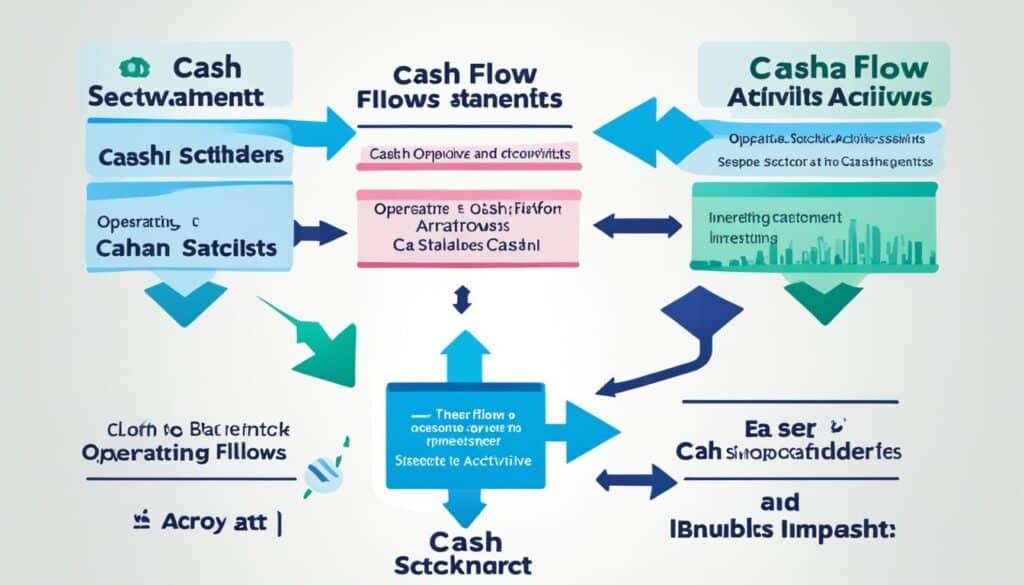Cash flow analysis is key for managing a company’s finances. It shows the cash available for paying bills and growing. It’s crucial for companies, investors, and analysts to look at cash flow. This helps them understand a company’s financial situation and consider investing. The statement of cash flow shows where a company gets its money and how it uses it.
This statement highlights the net cash flow of a company. It shows cash flow from operations, cash flow from investing, and cash flow from financing. The method used, accrual accounting or cash accounting, affects how the statement looks. In cash flow analysis, key points like the operations/net sales ratio, free cash flow, and comprehensive free cash flow coverage are important.
Key Takeaways
- Cash flow analysis is crucial for understanding a company’s financial health and performance.
- The cash flow statement provides insights into a company’s sources and uses of cash across operating, investing, and financing activities.
- Key metrics like operating cash flow, free cash flow, and comprehensive free cash flow coverage offer valuable indicators of a company’s efficiency and liquidity.
- Analyzing cash flow in conjunction with other financial statements allows for a more comprehensive assessment of a company’s financial position, profitability, and long-term sustainability.
- Understanding the differences between accrual and cash accounting is important for interpreting the cash flow statement.
Understanding Cash Flow
Cash flow shows the money a business makes or spends in a certain time. It’s not just about profits. Money flowing in and out of a business is its cash flow. Profits are what’s left when you subtract expenses from income.
What is Cash Flow?
Companies track three main cash flow types to measure their health: cash flow from operating activities, cash flow from investing activities, and cash flow from financing activities. Knowing your income sources and spending helps keep your company strong.
Also Read: How Do I Save For Emergencies In My Financial Planning?
Importance of Cash Flow Management
Managing cash flow well is key to financial health. Watching cash forecasts helps companies avoid running out of money. This preparedness is crucial for success and surviving market changes.
Types of Cash Flows
Companies usually focus on three cash flow types:
- Cash flow from operating activities
- Cash flow from investing activities
- Cash flow from financing activities
Understanding how money moves in and out of these areas is vital for a company’s financial well-being.
Also Read: What Are The Financial Instruments Available For Wealth Growth?
Cash Flow from Operations

The first part of the cash flow statement looks at
cash flows from operating activities (CFO)
. It includes the money coming in and going out from the day-to-day business. This part starts with the company’s net income. Then, it changes it to show the real cash involved in running the business. It’s all about how much money is really moving in and out from the company’s key business activities.
cash flows and outflows that stem directly from a company’s main business activities
. For example, it covers buying and selling products, paying workers, and more. It doesn’t count money from investments, debts, or payments to shareholders. These are not the main money movements of the business.
Operating Cash Flow (OCF)
When we talk about accounts receivable, it’s not just about cash. If a company sells more during a period, its receivables might increase. But, this doesn’t mean they got more cash right then. The cash flow statement adjusts things like receivables in the company’s income. This helps show how much real cash is or isn’t coming in or going out. It also looks at things like accounts payable, and costs like depreciation without actual cash spending.
Also Read: How Do I Evaluate A Stocks Before Investing?
Components of Operating Cash Flow
. The operations section shows the money the company made or spent from selling its main products, handling its bills, and such. It tells us about the company’s efficiency in managing its money day-to-day. This includes looking at the time it takes to make cash from selling goods, paying bills, and so on. Understanding this helps investors and experts see how good the company is at turning its work into real cash. This is key for keeping the business going and growing.
Cash Flow from Investing

The cash flow statement looks at money from investing activities. Here, we see cash spent or made from gains and losses of investments. It also shows the cash spent on things like property and equipment.
Capital Expenditures
Analysts watch a company’s capital expenditures (CapEx) closely here. If CapEx goes up, it usually means less cash flow. Yet, this isn’t always bad. It might mean the company is investing for its future growth.
Firms that spend a lot on CapEx are often looking to expand. They might be improving their fixed assets and property, plant, and equipment for the long term.
Also Read: How Can I Calculate Capital Gains On Real Estate Investments?
Asset Sales and Acquisitions
Having a strong cash flow in investments can be good. But investors usually like companies more when they make most of their cash from their main business. Not from investing or financing.
Companies also make money in the investing part by selling off big assets. This includes things like selling equipment or property. They might also buy new assets. This process of selling and buying is part of the investing cash flow section.
| Metric | Description | Importance |
|---|---|---|
| Capital Expenditures (CapEx) | Cash spent on the purchase, repair, and maintenance of property, plant, and equipment (PP&E) | Shows how much a company is investing in its future |
| Asset Sales | Cash received from selling fixed assets or other long-term investments | Brings in cash, but could mean the company is selling rather than growing |
| Asset Acquisitions | Cash used to buy fixed assets or other long-term investments | Shows the company is spending money to grow and be more competitive |
Cash Flow from Financing
Cash flows from financing (CFF) is the final part of the cash flow statement. It shows the cash used in business financing. It talks about the cash between a company, its owners, and lenders. Cash mainly comes from debt or selling shares.
Debt and Equity Transactions
This part shows details found in a company’s annual 10-K report. Companies share how they get money for growth, like selling shares or getting loans. It also tells us about loans taken or paid back.
Dividends and Share Buybacks
It helps analysts see if a company gives money out as dividends or buying back its own shares. A positive number means more money is coming in than going out. A negative one could show paying off debt or making these payments.
Also Read: Top 9 Technology Trend You Must Keep An Eye On
Cash Flow Metrics and Ratios
Looking at a company’s cash flow is more than checking its statement. By examining figures like the operating cash flow/net sales ratio or free cash flow (FCF), we get a deep look into a company’s health. These cash flow metrics and ratios help us understand its financial status, how easily it can access funds, and its effectiveness.
Operating Cash Flow/Net Sales Ratio
The operating cash flow/net sales ratio tells us how much cash a company makes for every sales dollar. It’s a key measure of how well a company can turn sales into cash. This is vital for running the business and making investments.
Free Cash Flow
Free cash flow (FCF) is all about the cash a company generates after accounting for growing and maintaining the business. Investors track this closely. It helps them see if a company can pay dividends, do share buybacks, or fund new moves without needing loans.
Comprehensive Free Cash Flow Coverage
The comprehensive free cash flow coverage ratio shows how well a company’s operations can cover its costs using cash. A higher ratio means the company is in a good spot. It shows they can easily handle their expenses using their cash flow.
| Metric | Description | Interpretation |
|---|---|---|
| Operating Cash Flow/Net Sales Ratio | Percentage of net operating cash flow to net sales | Indicates how many dollars of cash are generated for every dollar of sales |
| Free Cash Flow (FCF) | Net operating cash flow minus capital expenditures | Measures a company’s efficiency in generating cash and its capacity to fund growth, dividends, and share buybacks |
| Comprehensive Free Cash Flow Coverage | FCF divided by net operating cash flow | Provides a comprehensive view of a company’s ability to generate cash from operations and cover its obligations |
Cash Flow Analysis

Cash flow analysis looks at the cash flow within a company. It tracks where money comes from and where it goes. It shows how much money a company has after paying bills. If this number is positive, the company is doing well. If it’s negative, the company might be in trouble financially.
Determining a company’s cash flows uses its cash flow statement. This analysis helps you see if your business can keep going. Healthy cash flow means the business is likely to succeed. But if cash flow is in the negative for a long time, it could be a sign of bankruptcy.
| Key Cash Flow Metrics | Description |
|---|---|
| Cash Flow Analysis | Examines the sources and uses of cash within a company |
| Cash Flow Forecasting | Predicts future cash inflows and cash outflows |
| Cash Flow Projections | Estimates future cash flow based on current trends and assumptions |
| Cash Flow Patterns | Identifies recurring cash flow cycles and trends |
| Cash Flow Variability | Measures the fluctuations in a company’s cash flow |
| Cash Flow Efficiency | Evaluates how effectively a company manages its cash flow |
| Cash Flow Control | Focuses on managing and optimizing cash inflows and cash outflows |
| Cash Flow Improvement | Identifies opportunities to enhance a company’s cash flow |
| Cash Flow Problems | Addresses issues that lead to cash flow challenges |
| Cash Flow Solutions | Implements strategies to resolve cash flow problems |
Finally, cash flow analysis allows deep insight into a company’s financial well-being. By looking at its money usage and income from different areas, it tells a story. This story can help investors and those who follow the market understand if a company is strong or weak.
Cash Flow

Cash flow is vital for all businesses. It means having enough money to cover costs and invest in growth. Knowing how cash moves in and out helps a company stay financially healthy. This way, they can plan smartly for future business activities. These activities can boost earnings and ensure the company grows.
It’s important to note, cash flow isn’t the same as profit. Profits happen immediately when a sale is made. But the cash might come in later. This distinction is key to managing a company’s finances successfully. Cash and earnings are different aspects of a business’s financial health.
Role in Financial Health Assessment
Looking at a company’s cash flow and health helps understand its financial position. By checking where cash comes from and goes, businesses can identify risks. They can also spot opportunities to grow or improve their value.
Relationship with Profit
Although profits are important, cash flow is more telling of a company’s health. Positive cash flow allows a business to keep running, invest in its growth, and face tough economic times. It’s key to long-term financial strength.
Cash Flow Statement: Overview

A cash flow statement looks at how money moves in and out of a company. It shows where the money comes from and where it goes. This helps investors and analysts see how the business is doing.
Purpose and Components
The cash flow statement is quite straightforward compared to other financial statements. It shows money coming in from operations, investments, and financing. The total cash from these areas is known as net cash flow.
Accrual vs. Cash Accounting
Accounting has two main types: accrual and cash. Most big companies go by accrual, where profits on the income statement might not match actual cash. However, the cash flow statement sticks to real cash transactions.
Cash Flow and Financial Decisions
Looking at cash flow is key for making smart financial choices, whether for small startups or big companies. It shows how a business uses its money for growth, handles debt, and rewards its investors. Cash flow looks at money from sales, what’s spent on growth, and how debts are managed.
Investment and Growth Strategies
When investors check a company’s spending on improving and building new things, they’re looking at cash flow from investing. A company that’s expanding will put more cash into things like buildings and machines. This shows a commitment to growing.
Debt Management
The cash flow from financing helps us see how well a company is handling debt. It looks at money from loans, paying off debts, and more. Strong debt management means a company is financially secure and can pay its debts.
Dividend and Buyback Policies
For those interested in getting dividends from a company, looking at how cash is used in financing helps. It shows the cash paid out to shareholders. This section also gives a clue about whether the company buys back its own shares. By examining this data, investors gain insight into how a company shares its profits and uses its cash.
Also Read: Easy Ways To Manage Your Money For A Better Future
Conclusion
Cash flow analysis helps us understand a company’s financial health and how well it’s performing. We look at the cash inflows and outflows from operating, investing, and financing activities. This shows investors and analysts if a company can generate and manage cash, run well, and invest smartly. Metrics like operating cash flow, free cash flow, and comprehensive free cash flow coverage tell us about a company’s efficiency and liquidity.
A thorough cash flow analysis with other financial statements provides a full picture of a company’s financial health, profitability, and future success. Understanding cash flow management, forecasting, and projection techniques is key. This knowledge is important for financial strategy, budgeting, and using cash flow management tools well. With this, companies can make better financial decisions, improve their financial reports, and enhance their financial analysis and decision-making.




